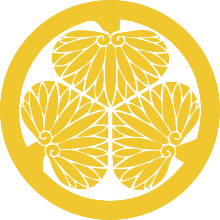Owari branch
| Tokugawa Owari 尾張徳川家 | |
|---|---|
|
| |
| Home province | Owari |
| Parent house | Tokugawa clan |
| Titles | Daimyo |
| Founder | Tokugawa Yoshinao |
| Final ruler | Tokugawa Munechika |
| Current head | Tokugawa Yoshitaka |
| Founding year | 1610 |
| Dissolution | still extant |
| Ruled until | 1800 (death of Tokugawa Munechika) |


The Owari (尾張徳川家 Owari Tokugawa-ke) branch of the Tokugawa clan is the seniormost house of the Gosanke ("three honourable houses of the Tokugawa").[1] Originally descended from Tokugawa Yoshinao, the ninth son of Tokugawa Ieyasu, the original line became extinct in 1800 with the death of the ninth lord and family head. It has since been kept in existence through repeated adoptions from the two remaining houses, and is currently headed by a member of the Kishu branch. For over 250 years, the Owari family ruled Owari Domain, the area surrounding present day Nagoya, Aichi Prefecture, using Nagoya Castle as its main base.[2] Another residence was the Ōzone Shimoyashiki.
The treasures of the Owari branch are kept in the Tokugawa Art Museum in Nagoya.
The present head of the family is Tokugawa Yoshitaka.
Heads
- Tokugawa Yoshinao (1601–1650)
- Tokugawa Mitsutomo (1625–1700)
- Tokugawa Tsunanari (1652–1699)
- Tokugawa Yoshimichi (1689–1713)
- Tokugawa Gorōta (1711–1713)
- Tokugawa Tsugutomo (1692–1731)
- Tokugawa Muneharu (1696–1764)
- Tokugawa Munekatsu (1705–1761)
- Tokugawa Munechika (1733–1800)
- Tokugawa Naritomo (1793–1850)
- Tokugawa Nariharu (1819–1839)
- Tokugawa Naritaka (1810–1845)
- Tokugawa Yoshitsugu (1836–1849)
- Tokugawa Yoshikatsu (1824–1883)
- Tokugawa Mochinaga (1831–1884)
- Tokugawa Yoshinori (1858–1875)
- Tokugawa Yoshikatsu (1824–1883)
- Tokugawa Yoshiakira(1863-1908)
- Tokugawa Yoshichika(1886-1976)
- Tokugawa Yoshitomu(1911-1992)
- Tokugawa Yoshinobu (1933-2005)
- Tokugawa Yoshitaka (born 1961)
Simplified family tree
 Tokugawa Ieyasu, 1st Tokugawa Shōgun (1543-1616; r. 1603-1605)
Tokugawa Ieyasu, 1st Tokugawa Shōgun (1543-1616; r. 1603-1605)
 I.Yoshinao, 1st Lord of Owari (cr. 1610) (1601-1650; r. 1610-1650)
I.Yoshinao, 1st Lord of Owari (cr. 1610) (1601-1650; r. 1610-1650)
 II. Mitsutomo, 2nd Lord of Owari (1625-1700; r. 1650-1693)
II. Mitsutomo, 2nd Lord of Owari (1625-1700; r. 1650-1693)
 III. Tsunanari, 3rd Lord of Owari (1652-1699; r. 1693-1699)
III. Tsunanari, 3rd Lord of Owari (1652-1699; r. 1693-1699)
 IV. Yoshimichi, 4th Lord of Owari (1689-1713; r. 1699-1713)
IV. Yoshimichi, 4th Lord of Owari (1689-1713; r. 1699-1713)
-
 V. Gorota, 5th Lord of Owari (1711-1713; r. 1713)
V. Gorota, 5th Lord of Owari (1711-1713; r. 1713)
-
 VI. Tsugutomo, 6th Lord of Owari (1692-1731; r. 1713-1730)
VI. Tsugutomo, 6th Lord of Owari (1692-1731; r. 1713-1730) VII. Muneharu, 7th Lord of Owari (1696-1764; r. 1730-1739)
VII. Muneharu, 7th Lord of Owari (1696-1764; r. 1730-1739)
- Matsudaira Tomoaki, Head of the Kawado-Kubo line (1678-1728)
 VIII. Munekatsu, 8th Lord of Owari (1705-1761; r. 1739-1761)
VIII. Munekatsu, 8th Lord of Owari (1705-1761; r. 1739-1761)
 IX. Munechika, 9th Lord of Owari (1733-1800; r. 1761-1799)
IX. Munechika, 9th Lord of Owari (1733-1800; r. 1761-1799)
- Yorinobu, 1st Lord of Kishu (1602-1671)
- Mitsutada, 2nd Lord of Kishu (1627-1705)
 Tokugawa Yoshimune, 5th Tokugawa Shōgun (1684-1751; r. 1716-1745)
Tokugawa Yoshimune, 5th Tokugawa Shōgun (1684-1751; r. 1716-1745)
- Munetada, 1st head of the Hitotsubashi-Tokugawa line (1721-1765)
- Harusada, 2nd head of the Hitotsubashi-Tokugawa line (1751-1827)
 Tokugawa Ienari, 11th Tokugawa Shōgun (1773-1841; r. 1786-1841)
Tokugawa Ienari, 11th Tokugawa Shōgun (1773-1841; r. 1786-1841)
 XI. Nariharu, 11th Lord of Owari (1819-1839; r. 1827-1839)
XI. Nariharu, 11th Lord of Owari (1819-1839; r. 1827-1839) XII. Naritaka, 12th Lord of Owari (1810-1845; r. 1839-1845)
XII. Naritaka, 12th Lord of Owari (1810-1845; r. 1839-1845)
- Harukuni (1776-1793)
 X. Naritomo, 10th Lord of Owari (1793-1850; r. 1800-1827)
X. Naritomo, 10th Lord of Owari (1793-1850; r. 1800-1827)
- Narimasa, 3rd head of the Tayasu-Tokugawa line (1779-1848)
 XIII. Yoshitsugu, 13th Lord of Owari (1836-1849; r. 1845-1849)
XIII. Yoshitsugu, 13th Lord of Owari (1836-1849; r. 1845-1849)- Matsudaira Yoshinaga, 16th Lord of Fukui (1828-1890)
- Yoshichika, 19th family head, 2nd Marquess (1886-1976; 19th family head: 1908-1976; Marquess: 1908-1947)
- Yoshitomu, 20th family head (1911-1992; 20th family head: 1976-1992)
- Michiko (b. 1936) m. Tokugawa Yoshinobu (Hotta), 21st family head (1933-2005) (see below)
- Yoshitomu, 20th family head (1911-1992; 20th family head: 1976-1992)
- Yoshichika, 19th family head, 2nd Marquess (1886-1976; 19th family head: 1908-1976; Marquess: 1908-1947)
- Fude-hime (1830-1886), m. Nabeshima Naomasa, 10th Lord of Saga (1815-1871)
- Nabeshima Naotō, 1st Viscount (1858-1910)
- Hotta Masatsune, 2nd Count (1887-1951)
- Tokugawa Yoshinobu (Hotta), 21st family head (1933-2005; 21st family head: 1992-2005), m. Tokugawa Michiko (b. 1936) (see above:)
- Yoshitaka, 22nd family head (b. 1961; 22nd family head: 2005-present)
- Tokugawa Yoshinobu (Hotta), 21st family head (1933-2005; 21st family head: 1992-2005), m. Tokugawa Michiko (b. 1936) (see above:)
- Hotta Masatsune, 2nd Count (1887-1951)
- Nabeshima Naotō, 1st Viscount (1858-1910)
- Harusada, 2nd head of the Hitotsubashi-Tokugawa line (1751-1827)
- Munetada, 1st head of the Hitotsubashi-Tokugawa line (1721-1765)
- Mitsutada, 2nd Lord of Kishu (1627-1705)
- Yorifusa, 1st Lord of Mito (1603-1661)
- Matsudaira Yorishige, 1st Lord of Takamatsu (1622-1695)
- Matsudaira Yoritoshi (1661-1687)
- Matsudaira Yoritoyo, 3rd Lord of Takamatsu (1680-1735)
- Munetaka, 4th Lord of Mito (1705-1730)
- Munemoto, 5th Lord of Mito (1728-1766)
- Harumori, 6th Lord of Mito (1751-1805)
- Harutoshi, 7th Lord of Mito (1773-1816)
- Matsudaira Yorihiro, 9th Lord of Takamatsu (1798-1842)
- Matsudaira Yoritoshi, 11th Lord of Takamatsu, 1st Count (1834-1903)
- Yoshiakira, 18th family head, 1st Marquess (1863-1908; 18th family head: 1880-1908; Marquess: 1884)
- Matsudaira Yoritoshi, 11th Lord of Takamatsu, 1st Count (1834-1903)
- Matsudaira Yorihiro, 9th Lord of Takamatsu (1798-1842)
- Matsudaira Yoshikazu, 9th Lord of Takasu (1776-1832)
 XIV. Yoshikatsu, 14th Lord of Owari (1824-1883; r. 1849-1858)
XIV. Yoshikatsu, 14th Lord of Owari (1824-1883; r. 1849-1858)
 XVI. Yoshinori, 16th Lord of Owari, 16th family head (1858-1875; Lord: 1864-1869; Governor: 1869-1871; 16th family head: 1864-1875)
XVI. Yoshinori, 16th Lord of Owari, 16th family head (1858-1875; Lord: 1864-1869; Governor: 1869-1871; 16th family head: 1864-1875)
 XV (XVII). Mochinaga, 15th Lord of Owari, 17th family head (1831-1884; r. 1858-1863; 17th family head: 1875-1880)
XV (XVII). Mochinaga, 15th Lord of Owari, 17th family head (1831-1884; r. 1858-1863; 17th family head: 1875-1880)
- Harutoshi, 7th Lord of Mito (1773-1816)
- Harumori, 6th Lord of Mito (1751-1805)
- Munemoto, 5th Lord of Mito (1728-1766)
- Munetaka, 4th Lord of Mito (1705-1730)
- Matsudaira Yoritoyo, 3rd Lord of Takamatsu (1680-1735)
- Matsudaira Yoritoshi (1661-1687)
- Matsudaira Yorishige, 1st Lord of Takamatsu (1622-1695)
References
- ↑ Hosa Library, City of Nagoya. Hosa Library. Accessed July 4, 2007.
- ↑ Usually, the clan had about 6,000 Samarai and other troops at its disposal. Nagoya Castle. Urabe Research Laboratory. Accessed July 4, 2007.
- ↑ Genealogy (jp)

